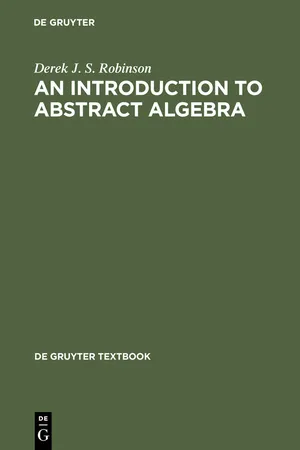
- 292 pages
- English
- PDF
- Available on iOS & Android
eBook - PDF
An Introduction to Abstract Algebra
Frequently asked questions
Yes, you can cancel anytime from the Subscription tab in your account settings on the Perlego website. Your subscription will stay active until the end of your current billing period. Learn how to cancel your subscription.
No, books cannot be downloaded as external files, such as PDFs, for use outside of Perlego. However, you can download books within the Perlego app for offline reading on mobile or tablet. Learn more here.
Perlego offers two plans: Essential and Complete
- Essential is ideal for learners and professionals who enjoy exploring a wide range of subjects. Access the Essential Library with 800,000+ trusted titles and best-sellers across business, personal growth, and the humanities. Includes unlimited reading time and Standard Read Aloud voice.
- Complete: Perfect for advanced learners and researchers needing full, unrestricted access. Unlock 1.4M+ books across hundreds of subjects, including academic and specialized titles. The Complete Plan also includes advanced features like Premium Read Aloud and Research Assistant.
We are an online textbook subscription service, where you can get access to an entire online library for less than the price of a single book per month. With over 1 million books across 1000+ topics, we’ve got you covered! Learn more here.
Look out for the read-aloud symbol on your next book to see if you can listen to it. The read-aloud tool reads text aloud for you, highlighting the text as it is being read. You can pause it, speed it up and slow it down. Learn more here.
Yes! You can use the Perlego app on both iOS or Android devices to read anytime, anywhere — even offline. Perfect for commutes or when you’re on the go.
Please note we cannot support devices running on iOS 13 and Android 7 or earlier. Learn more about using the app.
Please note we cannot support devices running on iOS 13 and Android 7 or earlier. Learn more about using the app.
Yes, you can access An Introduction to Abstract Algebra by Derek J. S. Robinson in PDF and/or ePUB format, as well as other popular books in Mathematics & Algebra. We have over one million books available in our catalogue for you to explore.
Information
Table of contents
- 1 Sets, relations and functions
- 1.1 Sets and subsets
- 1.2 Relations, equivalence relations and partial orders
- 1.3 Functions
- 1.4 Cardinality
- 2 The integers
- 2.1 Well-ordering and mathematical induction
- 2.2 Division in the integers
- 2.3 Congruences
- 3 Introduction to groups
- 3.1 Permutations of a set
- 3.2 Binary operations: semigroups, monoids and groups
- 3.3 Groups and subgroups
- 4 Cosets, quotient groups and homomorphisms
- 4.1 Cosets and Lagrange’s Theorem
- 4.2 Normal subgroups and quotient groups
- 4.3 Homomorphisms of groups
- 5 Groups acting on sets
- 5.1 Group actions and permutation representations
- 5.2 Orbits and stabilizers
- 5.3 Applications to the structure of groups
- 5.4 Applications to combinatorics – counting labellings and graphs
- 6 Introduction to rings
- 6.1 Definition and elementary properties of rings
- 6.2 Subrings and ideals
- 6.3 Integral domains, division rings and fields
- 7 Division in rings
- 7.1 Euclidean domains
- 7.2 Principal ideal domains
- 7.3 Unique factorization in integral domains
- 7.4 Roots of polynomials and splitting fields
- 8 Vector spaces
- 8.1 Vector spaces and subspaces
- 8.2 Linear independence, basis and dimension
- 8.3 Linear mappings
- 8.4 Orthogonality in vector spaces
- 9 The structure of groups
- 9.1 The Jordan-Holder Theorem
- 9.2 Solvable and nilpotent groups
- 9.3 Theorems on finite solvable groups
- 10 Introduction to the theory of fields
- 10.1 Field extensions
- 10.2 Constructions with ruler and compass
- 10.3 Finite fields
- 10.4 Applications to latin squares and Steiner triple systems
- 11 Galois theory
- 11.1 Normal and separable extensions
- 11.2 Automorphisms of field extensions
- 11.3 The Fundamental Theorem of Galois Theory
- 11.4 Solvability of equations by radicals
- 12 Further topics
- 12.1 Zorn’s Lemma and its applications
- 12.2 More on roots of polynomials
- 12.3 Generators and relations for groups
- 12.4 An introduction to error correcting codes
- Bibliography
- Index of notation
- Index